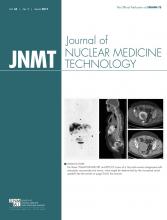
Sara G. Johnson, MBA, CNMT, NCT, FSNMMI-TS
When I found out that I was president-elect in spring 2016, I immediately started thinking about what I hoped to accomplish and how to get it done. The more I thought about SNMMI-TS, the more I realized that the Tech Section has been struggling over the past 5 years with some very heavy discussions. There have been several key areas that are discussed in every meeting: entry-level education, advanced degrees, scope-of-practice infringement, and the sustainability of technologists for the future.
This past September, the executive board had the opportunity to hold its first strategic discussion meeting, which brought together stakeholders within SNMMI-TS and served as a starting point for the rest of my presidency. The group of participants from that September meeting developed a list of mega issues that SNMMI-TS needs to tackle. In addition to the executive board’s weighing through these tough issues, the National Council of Representatives joined in and reserved most of its meeting time during the mid-winter meeting to discuss several mega issues. I am thrilled about the changes going on within SNMMI-TS and the increasing level of excitement within the community. I have included updates on several issues below.
SNMMI-TS and the technologist advocacy group team have also been active at the state level. In Maryland, SNMMI-TS efforts caused the Maryland Department of Health to revise its nuclear medicine technologist scope of practice to include the NMTCB(CT) certification. In Florida, we are still working to have lawmakers recognize the NMTCB(CT) credential along with the ARRT(CT). Once the American Society of Radiologic Technologists (ASRT) practice standards have been revised to include recognition of the NMTCB(CT) exam for nuclear medicine technologists, Florida lawmakers have indicated that they will recognize the credential. In New Mexico, we are addressing fusion-imaging regulations that would place many limitations on technologists.
In addition, this winter, ASRT released its practice standards for public comment. After an initial analysis of the proposed standards, SNMMI-TS has identified 5 key areas that we believe have not been included or may not be defined clearly enough for the needs of nuclear medicine technologists.
Adjunctive medications—need to define.
Hybrid imaging—need to define.
Handling of radiopharmaceuticals—need to define.
Drawing of blood—need to add.
Diagnostic CT—this is adequately stated in ASRT’s CT practice standards but not referenced in its nuclear medicine technologist standards. SNMMI-TS suggests that ASRT at least refer to or link to the CT standards for easy reference and to avoid confusion.
SNMMI-TS submitted formal comments to ASRT in November and is awaiting the revised document, which is due this summer.
SNMMI-TS is strengthening domestic and international relationships by partnering on a number of projects. For example, we have begun a multiple-nation project to develop an international minimum scope-of-practice standard for nuclear medicine technologists. Working with the Australian and New Zealand Society of Nuclear Medicine, we will utilize existing scope-of-practice documents from various countries to better understand what technologists around the globe are permitted to do. We will then write a statement outlining the minimal scope-of-practice standards that could be implemented by developing countries. This document will serve as a starting point to ensure that, throughout the world, patients undergoing nuclear medicine procedures receive care from adequately trained technologists. We hope to have a first draft by the 2017 annual meeting.
In addition, the Joint Review Committee on Educational Programs in Nuclear Medicine Technology began the process of updating the accreditation standards for nuclear medicine technology educational programs, and SNMMI-TS was invited to provide input on each published draft. Highlights of the revised standards include an entry-level competency list, increased emphasis on program assessment and graduate outcomes, inclusion of a standard on interprofessional education, an expanded glossary of terms, and additional requirements for entry-level programs transitioning to the master’s degree level to ensure these programs have a mechanism to remain accredited and meet the expectations for a graduate-level educational program.
During the mid-winter meeting, Joshua Reynolds, MBA, CNMT, RT(N)(CT)(MR), and Dmitry Beyder, MPA, CNMT, cochairs of the professional development task force, presented key data on SNMMI-TS volunteer engagement and the SNMMI-TS leadership academy. The items I found most interesting are that…
There are 165 unique committee volunteer opportunities within SNMMI-TS.
54 new volunteers stepped forward in 2016 (up from 20 in 2015).
There have been 128 graduates of the SNMMI-TS Leadership Academy (since its inception 10 years ago), and 108 of them are still active in SNMMI-TS.
In a survey of Leadership Academy graduates, 94.3% of respondents indicated that they have been involved in a leadership role within SNMMI-TS since they graduated. In addition, 72% indicated that they were more involved following the academy.
This information was especially exciting to me, as I truly believe that the success of SNMMI-TS is a direct result of our volunteers. Without our volunteers, we would not be able to accomplish our goals and move the field forward.
If you are not currently involved in SNMMI-TS but would like to become involved, the SNMMI-TS committee appointment process will be starting very soon. As in past years, we will once again be sending out a call for volunteers this spring.
It is the responsibility of SNMMI-TS to truly envision what the future will look like and ensure that our members are prepared. This year has already been packed with change and exciting new ventures, and I know that trend will continue over the next several months. But change, while unsettling sometimes, is necessary to ensure that we are addressing our members’ needs and that nuclear medicine technologists are an integral part of the health care team of the future.







